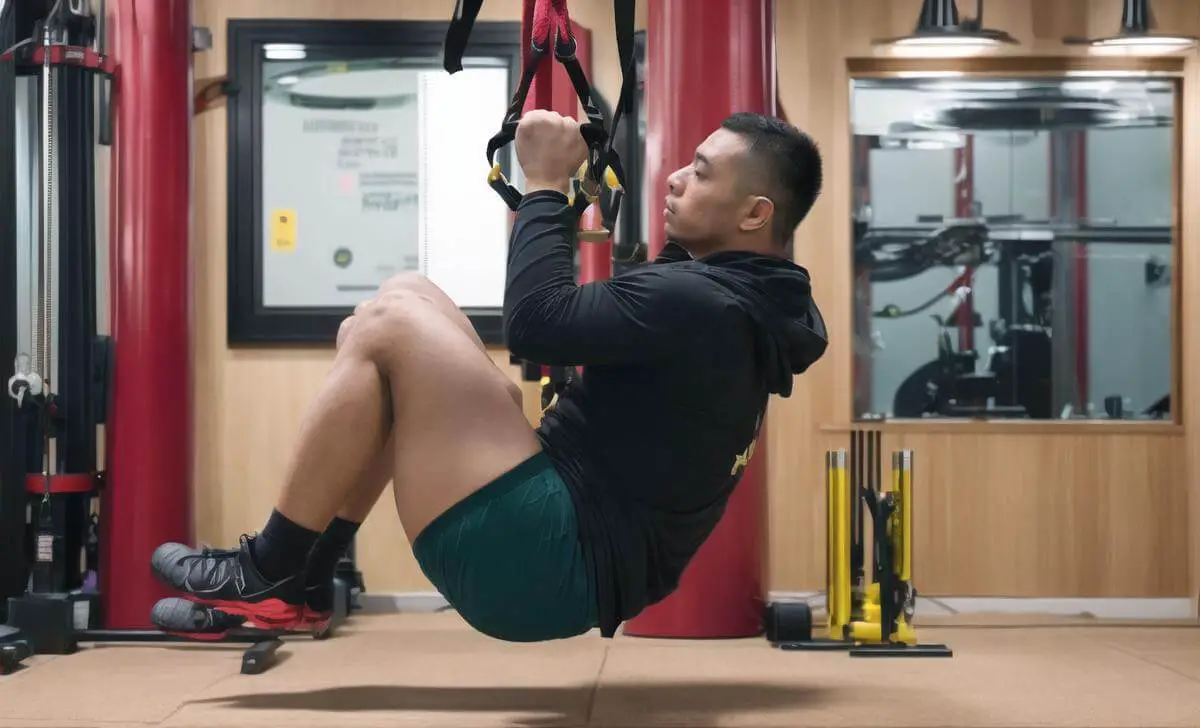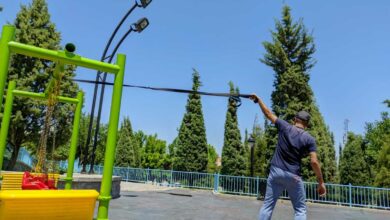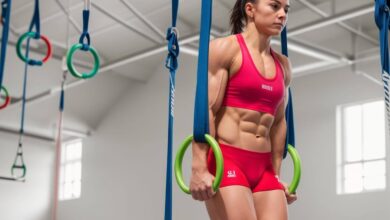Along with TRX rows, TRX pull up exercises primarily target the back muscles, and then shoulders and biceps. The suspension straps create unstable conditions, requiring your muscles to work together to maintain stability and control. This not only promotes strength development but also enhances coordination and balance.
Additionally, these exercises can be modified to accommodate your fitness level. By adjusting the angle of your body and the tension on the straps, you can increase or decrease the intensity of the exercise, making it suitable for individuals of all abilities. TRX pull-up, sometimes called TRX chin-up, engages multiple muscle groups simultaneously, delivering a full-body workout that will leave you feeling stronger and more empowered.
Table of Contents
What Muscles Does TRX Pull-up Work?
TRX back row and TRX pull-up are the two main TRX back exercises. Pull-ups primarily work the latissimus dorsi (lats), biceps, rhomboids, trapezius, posterior deltoids, and forearm muscles. These muscles are responsible for pulling motion, shoulder stabilization, and grip strength involved in pull-ups. Additionally, the core, lower back, and upper chest muscles are also engaged to a lesser extent. By targeting these muscle groups, pull-ups provide a comprehensive upper-body workout, promoting strength, stability, and functional fitness.
TRX Pull up Benefits
- Full Upper Body Engagement: TRX pull-up exercises challenge your upper body muscles, including your back, shoulders, and arms, to work cohesively. This holistic approach not only helps build strength but also improves stability and coordination.
- Scalable Difficulty: One of the biggest advantages of TRX pull-up exercises is their scalability. You can easily modify the exercise by changing the position of your body and adjusting the tension on the straps. This flexibility allows beginners to gradually build strength and challenges advanced users to push their limits.
- Range of motion: using suspension straps allows complete freedom of movement in TRX pull-up exercises.
1. How to Do a TRX Pull-up
The main difference between TRX pull-up and TRX row is that in the pull-up, the body is in vertical position. So, ensure you position your body below the anchor point, and your arms move in line with your body. If arms move in a diagonal direction, the movement changes to the back row.
- Adjust the straps to a suitable length.
- Position your body right below the anchor point.
- Hold TRX handles and allow arms to be fully stretched above your head.
- Pull yourself up, until your chin is above the handles and your elbows are down.
- Slowly descend to the initial position.
Try to pause a bit when you are at the top of the movement. This makes the exercise more challenging and activates your back muscles.
TRX Pull up Progression
For TRX pull-up progression, we can implement intelligent weight techniques to decrease the weight. Here we can use TRX assisted pull-up, also called TRX seated pull-up, and gradually build strength for normal TRX pull-up. This is an excellent starting point for beginners.
Learn about intelligent weight technique in TRX isometric exercises.
Subsequently, when we need more weight than our body weight, we can use TRX weighted pull-up by adding external weights to our body weight. TRX single-arm pull-up is also another way to increase the difficulty.
TRX Pull-up Variations by Grip Type
Freedom of movement in straps allows us to use all types of grip in TRX pull-ups.
TRX pronated pull-up is the most known type of TRX pull-up, which requires grasping handles with overhand grip and palm facing away from you. The overhand grip primarily targets the latissimus dorsi (lats), biceps, and upper back muscles.
TRX supinated pull-up is the reverse of the TRX pronated pull-up, and it requires an underhand grip in which your palms are facing toward you. The underhand grip also emphasizes the biceps, lower traps, and the muscles in the front of the upper body.
TRX neutral pull-up (parallel grip) is a state between overhand and underhand. With a neutral grip, your palms face each other, and your hands grip the TRX handles in a parallel position.
TRX twisting pull-up by twisting hands changes grip position between the previous three states during one movement.
Aside from handgrip types, we can have two other variations for all TRX pull-up exercises based on the distance between hands.
TRX wide grip pull-up is when hands are at both sides of the body and a bit wider than shoulder width. We can use double anchor points for this variation and have wider grip positions than shoulder width.
TRX close grip pull-up is when both arms are in front of the chest.
TRX Pull-up vs TRX Chin-up
Traditionally, it is called TRX chin-up when we use supinated grip with shoulder width apart, which puts more emphasis on the biceps. It is called TRX pull-up exercise when we use pronated grip, wider than shoulder-width apart, which puts less stress on the biceps and more on lats. However, they both primarily target the back and biceps, and there is little difference in their application.
2. TRX Seated Pull-up
TRX seated pull-up is a TRX pull-up variation that requires less strength than standard pull-up. In this exercise, we lay our feet on the ground that reduce the amount of weight we have to pull up. We can further assist with the pull-up by pushing feet against the floor. For this reason, this exercise is also called TRX assisted pull-up.
Another way to use TRX assisted pull–up is to help with the ascension movement up to the top, but then lift feet off the ground or reduce their pressure during the descending phase. This is also called TRX eccentric pull-up or TRX negative pull-up.

3. TRX L Sit Pull-up
The TRX L-sit pull-up is an advanced variation of the traditional pull-up exercise that targets the upper body, core, and hip flexors. It combines the pulling motion of a pull-up with the isometric hold of an L-sit, challenging both strength and stability.
- Adjust the Straps: Set the TRX suspension straps to an appropriate length.
- Grip the Handles.
- Initiate the Pull-Up: Begin the exercise by pulling your body up towards the handles.
- Transition to the L-sit Position: Once you reach the top of the pull-up, pause and lift your legs in front of you, creating an L-shape with your body.
- Lower with Control: Slowly lower your body back down, while maintaining the L-sit position as long as possible.
- Repeat: Perform the desired number of repetitions.

The TRX L-sit pull-up requires considerable upper body and core strength, as well as flexibility in the hip flexors. It is recommended to have a solid foundation in basic pull-ups and core exercises before attempting this advanced variation. Weakness in any of these two exercises prevents proper execution of this exercise. For this reason, TRX L sit pull-up is not recommended for beginners.
4. TRX Lat Pull down
TRX lat pull-down is quite similar to TRX seated pull-up, yet it further emphasizes lats and isolates them more effectively. The idea is taken from lat pull-down exercise in gym. Sometimes, TRX lat pull-down is also called TRX pull-down.
- Adjust the straps and hold handles while facing the anchor point.
- Bend your upper body forward so that your spine is in line with straps.
- Initiate the Pull-Down by pulling handles towards shoulders.
- After reaching the bottom position, extend your arms back to the initial position.
- Repeat for the desired number of repetitions.
We can do this exercise with wide grip, which is TRX wide grip lat pulldown, or with close grip, which is TRX close grip lat pulldown.

TRX lat pull-down also has similarities to TRX seated row, except in TRX seated row, arms are almost vertical to the torso, and it generates a rowing move. In TRX lat pull-down, however, arms are stretched above the head– generating a pull-up movement.
5. TRX Straight Arm Pulldown
Body positioning in TRX straight arm pulldown is similar to TRX back row. In fact, we can categorize it under rowing exercises. It is also known by other names, such as TRX swimmer pull, TRX straight arm lat pull down, or TRX long arm pull.
Here is how to perform TRX straight arm pulldown:
- Hold handles while standing and facing the anchor point.
- Lean backward and find a suitable angle for the exercise.
- Arms are extended in front of you and hold handles with overhand grip.
- While having your arms extended, pull handles downward and backward.
- Once your body reaches an almost vertical angle, start the return movement.

After reaching the top of the movement, you can implement the intelligent weight technique by pushing your toes against the ground. This creates initial resistance before gravity takes the lead in the movement.
An advanced variation of TRX straight arm pull down is by bending your upper body during the descending phase of the exercise. By hinging from the hips level, you can increase the range of motion in this exercise so that your arms come close to your ears. The important part for doing this variation properly is that you should use the pulling move to straighten your upper body. Try to engage lower back muscles as little as possible.
A close variation of this exercise is TRX Low Deltoid Fly which is a shoulder exercise. In that variation arms are at 45 degrees distance from the torso.
6. TRX Double Anchor Pull-up
We can do TRX pull-up exercises with double anchors, using two separate TRX straps, or using gymnastic rings. Using double anchors is useful for TRX wide grip pull-up. It allows holding handles wider than shoulder-width apart.
7. TRX Single Arm Pull-up
The TRX one-arm pull-up is an advanced variation of the pull-up exercise. It involves performing a pull-up motion using one arm while utilizing the TRX suspension straps. Since this TRX pull-up workout is extremely difficult, it is usually replaced by more feasible variations, such as TRX single arm row or TRX power pull.
We may also use intelligent weight technique and assist the workout by putting feet on the floor and squatting. This can be done by doing a complete set with one hand or alternating hands at each repetition. Both close grip and wide grip positions are possible.
8. TRX Archer Pull-up
Just like TRX single arm pull-up, TRX archer pull-up is an advanced pull-up workout. It is recommended to have a solid foundation in regular pull-ups and exercises that target the back before attempting this advanced variation. Using double anchor points or rings is more suitable for this workout.
- Starting position is like a standard pull-up with both handles in the hands.
- While one arm is ready for the standard pull-up, the other arm remains straight. Its hand turns outward, with the palm facing away from you and towards your side.
- Pull yourself up simultaneously with both arms.
- Alternate arms positions for the next repetition.
We use intelligent weight technique to assist with the movement.

9. TRX Commando Pull-up
Another variation of TRX pull up exercises is TRX commando pull-up. The main reason to use all these pull-up alternatives is to add variation to the exercise. Here is how to do it:
- Hold TRX handles in close-grip pull-up position, and with neutral grip.
- Begin pulling yourself upward towards one side of your chest. So, both hands pull towards that side.
- Descend and return to the initial position.
- Pull yourself up again towards the opposite side of the chest.
- Descend to the start position.
- Repeat.
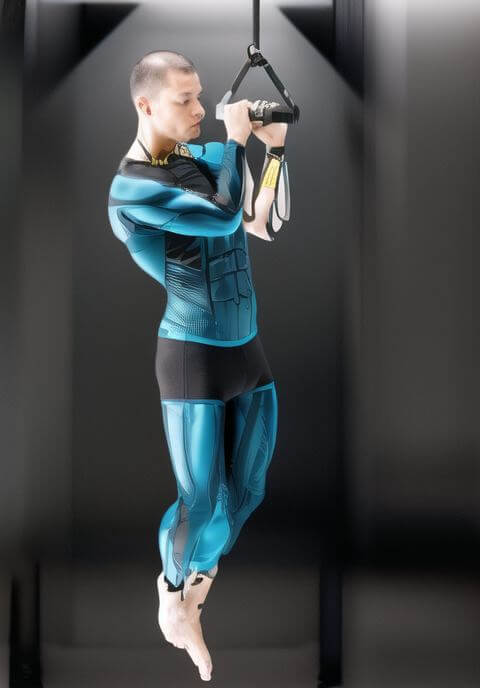
10. TRX Kipping Pull-up
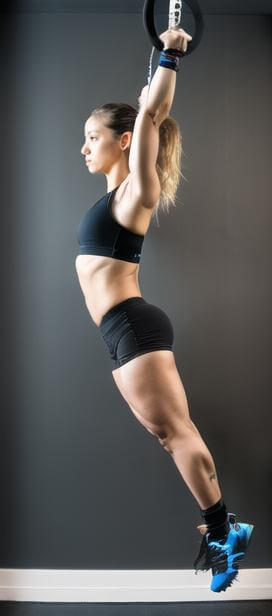
A TRX kipping pull-up is a dynamic variation of the traditional pull-up exercise that involves using momentum generated by the hips and legs to assist with the upward phase of the movement. It is commonly used in CrossFit workouts and gymnastics training.
- Starting Position: Begin by hanging from the straps with a wide and overhand grip.
- Swing: Initiate the movement by engaging your core and generating a swinging motion with your hips. Swing your legs backward as you simultaneously push your upper body forward.
- Arch Body Position: As you swing forward, aim to achieve an “arch” body position.
- Pull & Press: With the assistance of the hip movement, pull with your arms, engaging your back muscles and pulling your chest towards the handles.
- Descent: Lower yourself back down under control, extending your arms fully.
11. TRX Pullover
TRX pullover is another variation of TRX pull-up exercises. TRX pullover targets back and chest muscles. The unique body positioning in TRX pullover allows exercising back muscles at a particular angle that is not possible via other variations of pull-up. It complements exercises such as TRX swimmer pull.
TRX Front Lever and TRX Muscle up
Aside from the main TRX pull-up exercises, TRX Front Lever and TRX Muscle up are also complex exercises that target back muscles. They are combinations of multiple movements that enhance functionality and acrobatic abilities. These exercises are suitable for advanced trainees who mastered standard TRX pull-up workouts.
TRX Pull-up Variations with Training Systems
TRX plyometric pull-up, plyometric exercises involve rapid muscle contractions. To perform TRX plyometric pull-up, we can stand on the ground, extend arms above the head, hold TRX handles, and do jumping pull-up.
Pay attention that in the plyometric pull-up, we don’t slowly control the movement, nor do we pause at any point. Nevertheless, there is an explosive point between positive and negative phases of the pull-up at the top of the movement. Alternatively, we can pick this explosive point at the bottom of the movement during the descent.
TRX eccentric pull-up, like any eccentric exercise, emphasizes the negative phase of the movement; It is also called TRX negative pull-up. We can assist the positive phase by pushing feet onto the ground and overloading during the descending phase of the movement. There are different techniques for eccentric training, such as increasing time under tension during the negative phase.
TRX isometric pull-up is a TRX pull-up exercise that focuses on isometric contractions, which involve holding a static position to challenge and strengthen muscles at specific points in a range of motion. Once you reach the top of the pull-up, hold the position for a specific duration, aiming for an isometric contraction during 30–45 seconds. This point of iso hold can be anywhere in the range of motion of pull-up.
Trx vs Pull-up Bar
In the table below, we draw a concise comparison between TRX suspension trainer and pull-up bar for pull-up exercises.
| TRX | Pull-up Bar |
|---|---|
| Highly portable and can be easily set up anywhere with an anchor point. | Typically fixed and require a dedicated space for installation. |
| Offers adjustable straps, allowing for various angles and positions. Adds an element of instability. | Provide a stable and secure platform with fixed grip and a solid base. Reduce engagement of other muscles. |
| Wide range of TRX pull-ups exercises and even beyond pull-ups. | Primarily used for pull-ups and chin-ups. |
| The adjustable straps allow for modifications and progressions. | Adjustability is limited compared to TRX suspension trainers. |
| Straps allow a wide range of motion. | Limited range of motion due to fixed grip position. |
Nonetheless, suspension straps require an anchor point to be hung from. Hence, mounting a TRX pull-up bar in your home gym, can kill two birds with one stone.
Please note that some of the links on this website are affiliate links, which means that we may earn a commission if you click on the link and make a purchase. This won’t cost you anything extra.
Introducing the Anchor Gym patented hooks, the PULL UP BAR (PUB) Multi-station offers countless exercise options with ample wall clearance for suspension training. This space-saving, compact modular set-up is perfect for physical therapy offices, small commercial gyms, and home gyms. Plus, it comes with a lifetime guarantee!
Get your Anchor Gym PUB now and enjoy a clutter-free, indoor workout experience.
If you practice indoor but with no option to mount a bar to wall, you can get Basic Door Gym Pull up Bar which is easily installed in door frame. The bar has three grip positions (narrow/wide/neutral) to work your muscles from many different angles.
For outdoors and open spaces with no wall to mount the Bar, Calisthenics Racks: Pull-Up Bar | P-Bars are a suitable options.

To learn how to attach TRX to pull-up bar, study TRX home setup.
